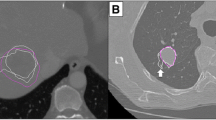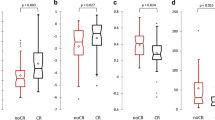Abstract
The purpose of this study was to evaluate the reproducibility of CT-volumetric tumour response assessment of pulmonary metastasis using variable volume change thresholds (VCT) and target lesions with response evaluation criteria in solid tumours (RECIST). Fifty consecutive patients with pulmonary metastases undergoing follow-up multislice CT under chemotherapy were assessed for response to chemotherapy with modifications to RECIST: (1) decreasing the percentual VCT for diagnosis of tumour response (range = 70%–20%), (2) reducing the number of target lesions (range = 1–5). Continuous and categorical observer agreements were tested by Bland and Altman and extended (κe) or non-weighted kappa (κ) and correlated with percentual VCT to predict observer agreement. A total of 202 metastases were evaluated (average volume = 522.4 mm3±902.4 mm3). General agreement on treatment response was very high (κe = 0.93–1), but was reduced with VCT < 35% (κe < 0.95). Kappa correlation with VCT values was strong (r=0.94–0.96; p≤0.0002). Average confidence decreased significantly at VCT < 45% (p < 0.01) and agreement on stable disease at VCT < 35% (κe < 0.95; p < 0.01). Reduction of target lesions (n < 3; VCT = 35%) resulted in decreased reader confidence (for n = 1: κ = 0.49; p < 0.05). Agreement for evaluation of treatment response was robust using VCT ≥35% and ≥3 metastases. This may translate into shortening of follow-up intervals or enable for response assessment with tumours displaying minimal volume change.


Similar content being viewed by others
References
Therasse P, Arbuck SG, Eisenhauer EA, Wanders J, Kaplan RS et al (2000) New guidelines to evaluate the response to treatment in solid tumors. J Natl Cancer Inst 92:205–216
Therasse P, Eiasenhauer EA, Verweij J (2006) RECIST revisited: a review Oberfeld validation studies on tumor assessment. Eur J Cancer 42:1031–1039
Hayes TG, Falchock GF, Varadhachary GR et al (2006) Phase I trial of oral talactoferrin alfa in refractory solid tumors. Invest New Drugs 24:233–240
Husband JE, Schwartz LH, Spencer J et al (2004) Eavluation of the response to treatment of solid tumours-a consensus statement of the International Cancer Imaging Society. Brit J Cancer 90:2256–2260
Wormanns D, Kohl G, Klotz E et al (2004) Volumetric measurement of pulmonary nodules at multi-row detector CT: in vivo reproducibility. Eur Radiol 14:86–92
Marten K, Auer F, Schmidt S, Kohl G, Rummeny EJ, Engelke C (2006) Inadequacy of manual measurements compared to automated CT volumetry in assessment of treatment response of pulmonary metastases using RECIST criteria. Eur Radiol 16:781–790
Tran LN, Brown MS, Goldin JG et al (2004) Comparison of treatment response classifications between unidimensional, bidimensional, and volumetric measurements of metastatic lung lesions on chest computed tomography. Acad Radiol 11:1355–1360
Marten K, Engelke C. Computer-aided detection and automated CT volumetry of pulmonary nodules. Eur Radiol 2006; DOI 10.1007/s00330-006-0410-3 [Epub ahead of print]
Fan L, Qian J, Odry BL et al (2002) Automatic segmentation of pulmonary nodules by using dynamic cross-correlation for interactive CAD systems. In: Sonka M, Fitzpatrick JM (eds) Medical imaging: Image processing. Proc SPIE 4684:1362–1396
Fleiss JL, Cuzick J (1979) The reliability of dichotomous judgements: unequal numbers of judges per subject. Appl Psychol Meas 3:537–542
Fleiss JL, Nee CM, Landis JR (1979) Large sample variance of kappa in the case of different sets of raters. Psychol Bull 86:974–977
Landis JR, Koch G (1977) The measurement of observer agreement for categorical data. Biometrics 33:159–174
Bland M, Altman DG (1986) Statistical methods for assessing the difference between two methods of measurement. Lancet 1(8476):307–310
Maxwell AE (1970) Comparing the classification of subjects by two independent judges. Br J Psychiatry 116:651–655
Thiesse P, Ollivier L, Di Stefano-Louineau D et al (1997) Response rate accuracy in oncology trials: reasons for interobserver variability. J Clin Oncol 15:3507–3514
Gwyther SJ, AApro MS, Hatty SR, Postmus PE, Smith IE (1999) Results of an independent oncology review board of pivotal clinical trials of gemcitabine in nonsmall cell lung cancer. Anticancer Drugs 10:693–698
Biganzoli L, Lohrisch C, Paridaens R, Therasse P, Piccart M (2002) Analysis of tow EORTC trials in metastatic breast cancer (MBC) support the recommendation of external response review (ERR) in trials with response rate (RR) as primary endpoint. Eur J Cancer 36(Suppl. 5):S90
Watanabe H, Yamamoto S, Kunitoh H et al (2003) Tumor response to chemotherapy: the validity and reproducibility of RECIST guidelines in NSCLC patients. Cancer Sci 94:1015–1020
Erasmus JJ, Gladish GW, Broemeling L, Sabloff BS, Truong MT, Herbst RS, Munden RF (2003) Interobserver and intraobserver variability in measurement of nonsmall-cell carcinoma of the lung lesions: implications for assessment of tumour response. J Clin Oncol 21:2574–2582
Grossi F, Belvedere O, Fasola G et al (1999) Tumour measurements on computer tomographic images of non-small cell lung cancer were similar among cancer professionals from different specialities. J Clin Oncol 17:25–30
Yankelevitz DF, Gupta R, Zhao B, Henschke CI (2000) Small pulmonary nodules: volumetrically determined growth rates based on CT evaluation. Radiology 217:251–256
Kostis WJ, Yankelevitz DF, Reeves AP, Fluture SC, Henschke CI (2004) Small pulmonary nodules: reproducibility of three-dimensional volumetric measurement and estimation of time to follow-up CT. Radiology 231:446–452
Chojniak R, Younes RN (2003) Pulmonary metastases tumor doubling time: assessment by computed tomography. Am J Clin Oncol 26:374–377
Schwartz LH, Mazumdar M, Brown W, Smith A, Paniek DM (2003) Variability in response assessment in solid tumors: effect of number of lesions chosen for measurement. Clin Cancer Res 9:4318–4323
Schwartz M (1961) A biomathematical approach to clinical tumour growth. Cancer 14:1272–1294
Zacharia TT, Saini S, Halpern EF, Sumner JE (2005) CT of colon cancer metastases to the liver using modified RECIST criteria: determining the ideal number of target lesions to measure. AJR Am J Roentgenol 186:1067–1070
Ratain M (2004) Phase II studies of modern drugs directed against new targets: If you are fazed, too, then resist RECIST. J Clin Oncol 22:4442–4444
Kernstine KH, Grannis FW Jr, Rotter AJ (2005) Is there a role for PET in the evaluation in subcentimeter pulmonary nodules? Semin Thorac Cardiovasc Surg 17:110–114
Author information
Authors and Affiliations
Corresponding author
Rights and permissions
About this article
Cite this article
Marten, K., Auer, F., Schmidt, S. et al. Automated CT volumetry of pulmonary metastases: the effect of a reduced growth threshold and target lesion number on the reliability of therapy response assessment using RECIST criteria. Eur Radiol 17, 2561–2571 (2007). https://doi.org/10.1007/s00330-007-0642-x
Received:
Revised:
Accepted:
Published:
Issue Date:
DOI: https://doi.org/10.1007/s00330-007-0642-x




